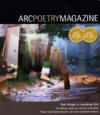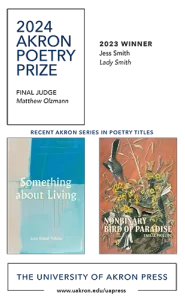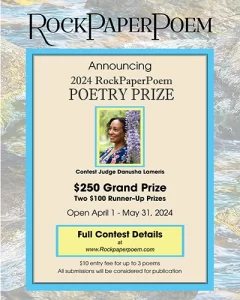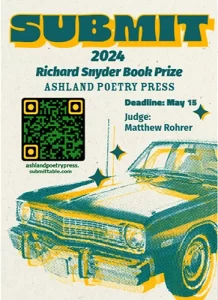Arc Poetry Magazine – 2013
The seventieth issue of Arc, an annual journal published in Ottawa, Canada, features an email interview with poet Elizabeth Bachinsky, in which she writes: “We really are living in hybrid times.” A fitting remark both for the “cultural capital” writers find themselves living with and for this intelligently edited gathering, which takes as its theme “Reuse and Recycle: Finding Poetry in Canada.” Poetry editor Shane Rhodes contributes the titular essay, considering reuse and recycling in the context of found poetry: its background in Canada, its shifting motivations, and its internet-driven permutations. With few exceptions, however, most of the work in Arc considers reuse obliquely and explores material subjects through honed language rather than through the repurposing of archival or computer-generated texts.
The seventieth issue of Arc, an annual journal published in Ottawa, Canada, features an email interview with poet Elizabeth Bachinsky, in which she writes: “We really are living in hybrid times.” A fitting remark both for the “cultural capital” writers find themselves living with and for this intelligently edited gathering, which takes as its theme “Reuse and Recycle: Finding Poetry in Canada.” Poetry editor Shane Rhodes contributes the titular essay, considering reuse and recycling in the context of found poetry: its background in Canada, its shifting motivations, and its internet-driven permutations. With few exceptions, however, most of the work in Arc considers reuse obliquely and explores material subjects through honed language rather than through the repurposing of archival or computer-generated texts.
As a first-time reader of the journal, I was especially taken by the poems—the different image banks they draw from, their singular music. Penned mainly by writers who have published full-length collections, the work is accomplished in form and subject matter. Here, everyday “cereal, vitamins / razorblades” exist alongside The Nutcracker. Horology, herringbone, and heaven inspire the authors as readily as taxidermy birds. Rilke’s famous opening line (“We cannot know his legendary head”) is re-contextualized in a poem on the trial of Omar Khadr. Pop culture (Archie Bunker re-runs), technology (camera-phones), travel (Hollywood), and sexuality (Pamela Anderson posters) mingle with animal imagery drawn from the northern hemisphere—and this is only a sampling.
In addition to familiar subjects, several poets employ reuse through repetition, including Caitlin Shayda Jones in “The Ducks and the Ducks”: “The ducks were born with suitcases and lei. Then ducks with / furrowed red mouths. Ducks made into candles wearing / scarves. Wooden ducks with straw bows and varnish . . .”
Jack Hannan in “On the infinite map,” a straightforward reflection on expectations, human vulnerability, and false optimism:
People came as they were, or as they wanted to be.
They thought, I am driven.
They thought, is this longing?
They thought, but this is fear. This is anger.
They sang the song called “What is love?”
They said drive, they said longing.
They said, as a matter of fact . . .
David Seymour in “This Object has been Assigned Aesthetic Value,” with its anaphora “The compartments,” and Elizabeth Bachinsky in “This Is How”—all of which steadily accumulate toward thoughtful, stinging conclusions. Varied as the works are, they often share an appealing sense of melancholy or darkness, well-earned and expansive: no self-pity, no facile observations.
Full-color art by Montreal-based Dil Hildebrand portrays the intersection of natural and man-made worlds, offering an arresting complement to the issue’s theme. In Haunted House, trees cast shadows on ruins. In Bioshelter, a torn mural occupies the center of what could be a post-apocalyptic scene. Possible Woods includes fragmented shapes, dream-detritus or the aftermath of another unspoken event. The artist’s palette is primordial, yet earth-browns enhanced by greens and blues also evoke the toxic and decaying—an intriguing juxtaposition to the writing, which similarly reveals beauty in unexpected places, as in Andy McGuire’s line “We pored over its oxidized frame” and Jan Conn’s “The green metallic hysteria we thought of as extreme sky.”
Other highlights include a multilingual essay on translation by Erín Moure, French poems by Nicole Brossard with English translations by Moure and Robert Majzels, a selection of poems from 2011-2012 poet-in-residence Rob Winger, and reviews of contemporary books.
Now in its thirty-fifth year of publication, Arc is elegantly produced and deserves recognition. Recommended for fans of dense imagery, subtle emotion, commanding voices, grace baring its teeth—to recycle and appropriate Bachinsky’s words, this is poetry that shows “how to wield a sword. A real sword, fool.”
[www.arcpoetry.ca]





